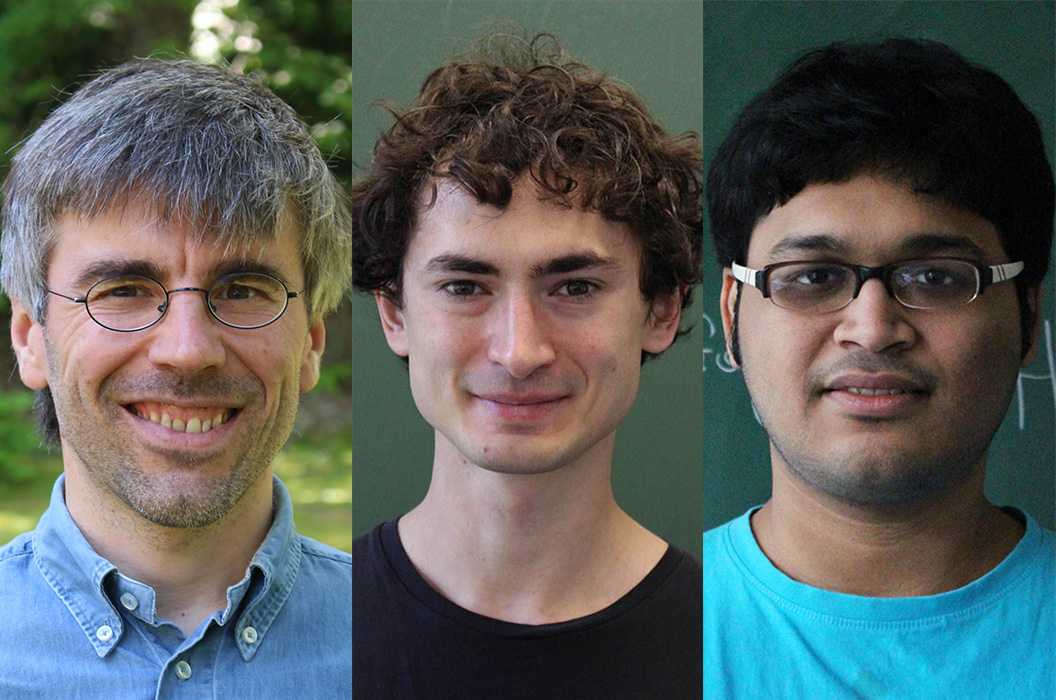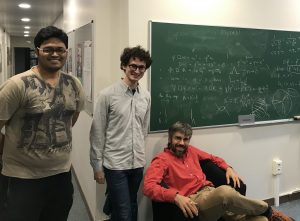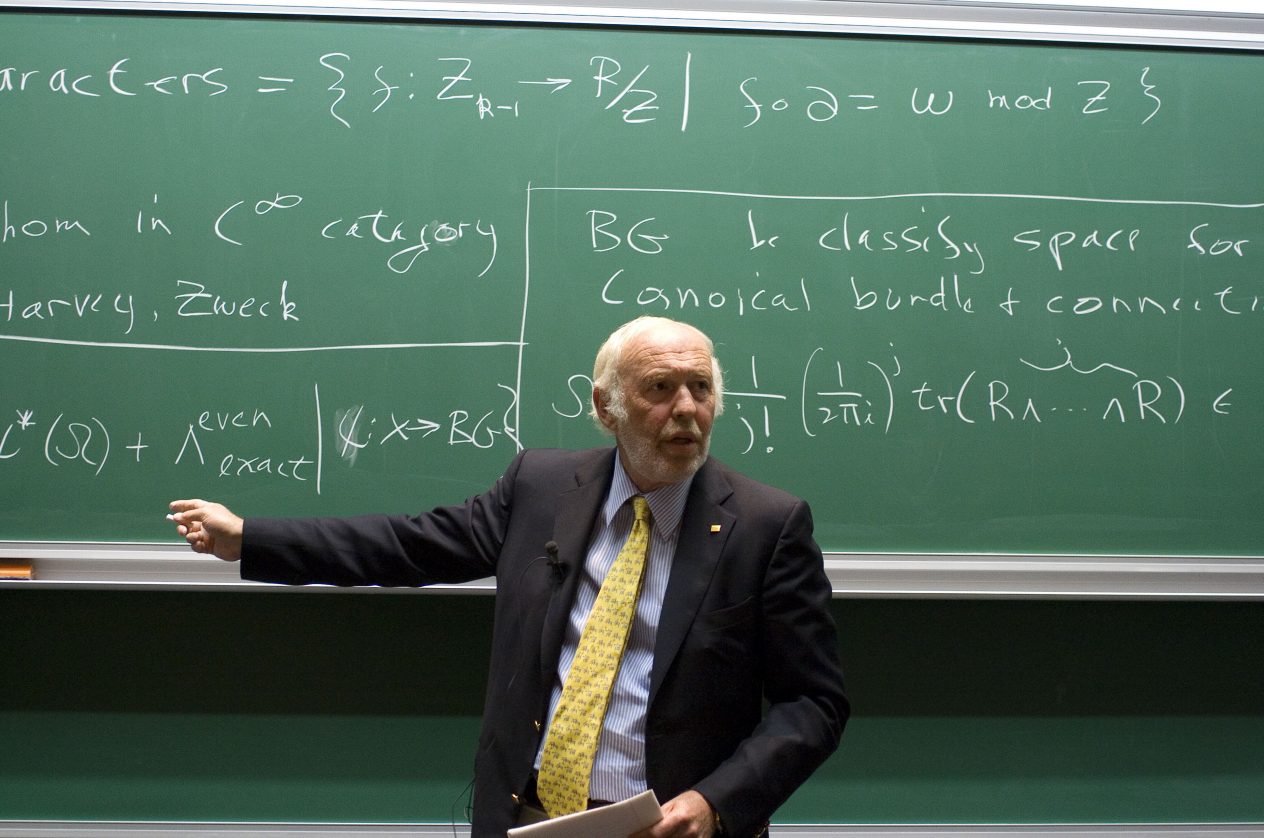 Press Release
Press Release
Slava Rychkov and collaborators find new results on the Random Field Ising Model
Press release – 8 September 2022
Slava Rychkov stumbled upon the many questions posed by the Parisi-Sourlas conjecture shortly after his arrival at IHES, at the end of 2017. He was participating in a conference on Disordered Systems organized by physicist Giorgio Parisi, a professor at Sapienza University of Rome, and the Cracking the Glass Simons Collaboration, where he had been invited because of his recent work on conformal bootstrap.
The Random Field Ising Model
Real systems are inherently disordered. Even the purest of crystalline solids has defects, that appear at random positions in the crystal and impact its properties at the macroscopic scale. To understand the role that disorder might play, physicists introduce small extra terms of disorder in a well-known model. Having been studied for more than a century, the Ising model is one of the best-known models in statistical physics, which makes it a good candidate. One of the simplest ways to introduce disorder in the Ising model is to add a random but constant magnetic field to each lattice site. The model that one obtains in so doing is called Random Field Ising Model (RFIM) which, despite its apparent simplicity, already poses a challenge.
To determine the role of the extra term, physicists set out to study how solutions to the RFIM might differ from the ones of the pure Ising model, particularly around the critical point. Does disorder change the universality class of the system? Or do universal quantities such as the critical exponents remain the same upon introduction of a random magnetic field?
Answering these questions could help to understand for example how the physical properties of certain materials might be affected by their inherent disorder.
When physicists started studying the RFIM in the 1970s they could quickly realize that the extra random feature introduces important differences in the critical behavior: while the classical Ising model is notoriously interesting in dimensions 1<d<4, d=1 being the lower critical dimension, at which no phase transition is observed, and d=4 being the upper critical dimension at which mean-field solutions become exact, in the RFIM the interesting dimensional range is 2<d<6. This is per se enough to significantly complicate the study in the disordered case, as an increase in the upper critical dimension implies that widespread perturbative renormalization group methods consisting in working in dimension d=6-e, for small values of e, will be hard to extend to the physically interesting dimensions: d=2 and d=3.
The Parisi-Sourlas Conjecture
Early applications of perturbative renormalization group techniques showed that critical exponents calculated just below the upper critical dimension 6 are the same as those calculated for the Ising Model around its upper critical dimension (d=4). This result was obtained by Amnon Aharony, Yoseph Imry and Shang-keng Ma in 1976. To explain this important property, Giorgio Parisi and Nicolas Sourlas, a colleague of Slava Rychkov at École normale supérieure in Paris, formulated an important conjecture extending this result to all dimensions d. By assuming that the fixed points in a disordered system are characterized by supersymmetric properties, Parisi and Sourlas were able to show that something called “dimensional reduction” occurs: the critical exponents for the disordered case in dimension d are the same as the ones of its pure (i.e. non-disordered) correspondent in d-2.
Weaknesses and strengths of the conjecture
If on one side the Parisi-Sourlas conjecture allowed to explain previous results obtained for the RFIM through perturbative renormalization group methods, and even though numerical simulations have recently confirmed the conjecture at d=5 (1), there is a series of paradoxes that have kept the physics community from fully trusting its validity.
Dimensional reduction predicts that the RFIM in d=3 should be equivalent to the Ising Model in d=1, but the latter shows no phase transition, while rigorous results show that the former does. Similarly, numerical results obtained for the RFIM in d=4 prove that the critical exponents are not the same as the ones calculated by Onsager for the 2-dimensional Ising model.
Yet, there are many cases that show that the Parisi-Sourlas conjecture cannot be ditched altogether.
There is a whole class of systems, for example, for which the conjecture works very well: the one of branched polymers. These are objects that can be thought of as a long polymeric backbone chain to which similar chains are attached at different points. Properties of a typical branched polymer can be described by a model which shares many qualitative features with RFIM, and whose corresponding pure analogue is the Lee-Yang model. Similarly to how the RFIM in 6 dimensions should have the same critical exponents as the Ising Model in 4 dimensions, branched polymers in d dimensions share the same universal features as the Lee-Yang model d-2 dimensions. Strikingly, for this class of systems that remains true for all values of d.
The work of Slava Rychkov, Apratim Kaviraj and Emilio Trevisani
When Slava Rychkov enters the story, in 2017, the spin-glass community had been stuck in an attempt to understand the conjecture for decades. Interested in such a long-lasting debate and curious about the important information that the Parisi-Sourlas conjecture seems to be able to provide despite its many limitations, he set out to tackle the Parisi-Sourlas conjecture together with his collaborators, Apratim Kaviraj and Emilio Trevisani, who at the time were both working as postdocs at École normale supérieure in Paris.

To do that they divided the problem into two sub-problems, which they solved separately. First, they proved that the existence of supersymmetric fixed points implied dimensional reduction. This means that if the fixed points of the RFIM have supersymmetric properties, then it is true that the universal properties of the RFIM in d dimensions are the same as for the Ising model in d-2 dimensions. This part of their work led to a first paper [1] devoted to supersymmetric CFT aspects, published in December 2019, and where they apply conformal bootstrap methods.
Once this first point was proved, they hypothesized that the breakdown of the Parisi-Sourlas conjecture at low dimensions could be explained by a critical dimension dc, below which the fixed points of the RFIM do not show supersymmetric properties. The idea that that could indeed be the case, and a pivotal contribution to their work, came from reading an article published in 1985 by John Cardy, currently professor emeritus at the University of Oxford and professor at the University of California, Berkeley. There, an ingenious transformation was applied to the RFIM Hamiltonian, making it clear that for the supersymmetry to hold, infinitely many perturbations should be negligible (or “irrelevant”, in the jargon of renormalization group theory). All those terms could indeed be neglected for d near 6, but a priori some of them could become non-negligible for lower d, the possibility that Cardy did not consider.
This second part of Slava Rychkov’s and his collaborators work required to look for those non-negligible perturbations. Are there any? After an exhaustive search, they could identify three classes of potentially non-negligible perturbations. Through a series of complex and subtle calculations, they could prove that two such perturbations do indeed become non-negligible below the critical dimension dc ≈ 4.5. Therefore, the Parisi-Sourlas hypothesis that the fixed points in the RFIM are characterized by supersymmetric properties holds at d>dc but not at d<dc.
A good sign that Slava Rychkov and his collaborators’ method is right is that it also gives consistent results in the case of branched polymers, to which Kaviraj and Trevisani have extended their reasoning in a third paper [3]. A fourth paper by Kaviraj, Rychkov and Trevisani, recently published on Physical Review Letters [4], summarizes their results and offers a greater picture.
These results have been positively welcomed by the physics community. Giorgio Parisi commented: « Slava Rychkov and his collaborators have done magnificent work by understanding in greater detail the origin of the so-called “Parisi-Sourlas” supersymmetry and the reasons for its success and its failure. It is an important step forward in this very difficult problem that has attracted my attention for more than forty years. »
John Cardy said: “This work is what I should have tried to do years ago, but at the time the task looked too daunting – so many different terms to account for. I’m pleased that it seems to resolve in a plausible scenario”.
Edouard Brézin, a physicist and a professor emeritus at École normale supérieure, said: “At last, after more than forty years of bewilderment, the long-standing puzzle on why and when supersymmetry implies a dimensional reduction is understood. The beautiful supersymmetric (SUSY) arguments of Parisi-Sourlas, for the random field Ising model (RFIM), was known to fail in three dimensions, whereas no failure was apparent for the model of branched polymers in which Parisi and Sourlas had found a similar SUSY, and a similar dimensional reduction. Rychkov and his collaborators have discovered the origin of the problem. The presence of a SUSY breaking operator, becoming relevant near five dimensions, explains why the dimensional reduction fails for the RFIM in four or three dimensions. Furthermore, the same authors have shown that the branched polymer problem is free of any relevant SUSY breaking”.
If they are right, Slava Rychkov and his collaborators might have finally found the conditions under which the Parisi-Sourlas conjecture is valid, thus answering a question that physicists have been struggling with for 40 years.
[1] A. Kaviraj, S. Rychkov and E. Trevisani, Random field Ising model and Parisi-Sourlas supersymmetry. Part I. Supersymmetric CFT, JHEP 04 (2020) 090 [arXiv:1912.01617]
[2] A. Kaviraj, S. Rychkov, and E. Trevisani, Random Field Ising Model and Parisi-Sourlas Supersymmetry II. Renormalization Group, JHEP 03 (2021) 219 [arXiv:2009.10087v3]
[3] A. Kaviraj and E. Trevisani, Random Field φ3 Model and Parisi-Sourlas Supersymmetry, [arXiv:2203.12629]
[4] A. Kaviraj, S. Rychkov and E. Trevisani, Parisi-Sourlas Supersymmetry in Random Field Models, Phys. Rev. Lett. 129, 045701 [arXiv:2112.06942]
(1) N. G. Fytas, V. Martin-Mayor, G. Parisi, M. Picco, and N. Sourlas Evidence for Supersymmetry in the Random-Field Ising Model at D=5, Phys. Rev. Lett. 122, 240603 [arXiv:1901.08473]



